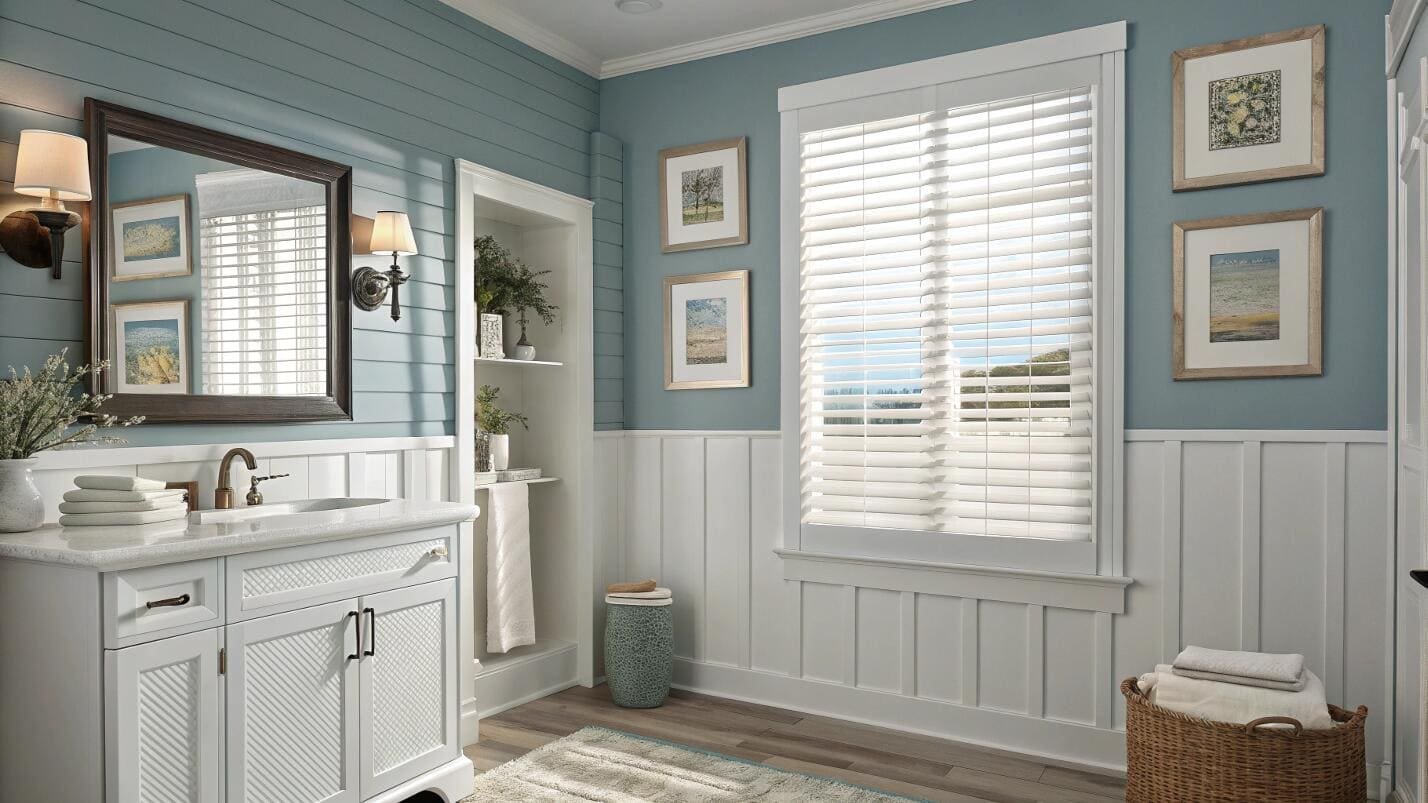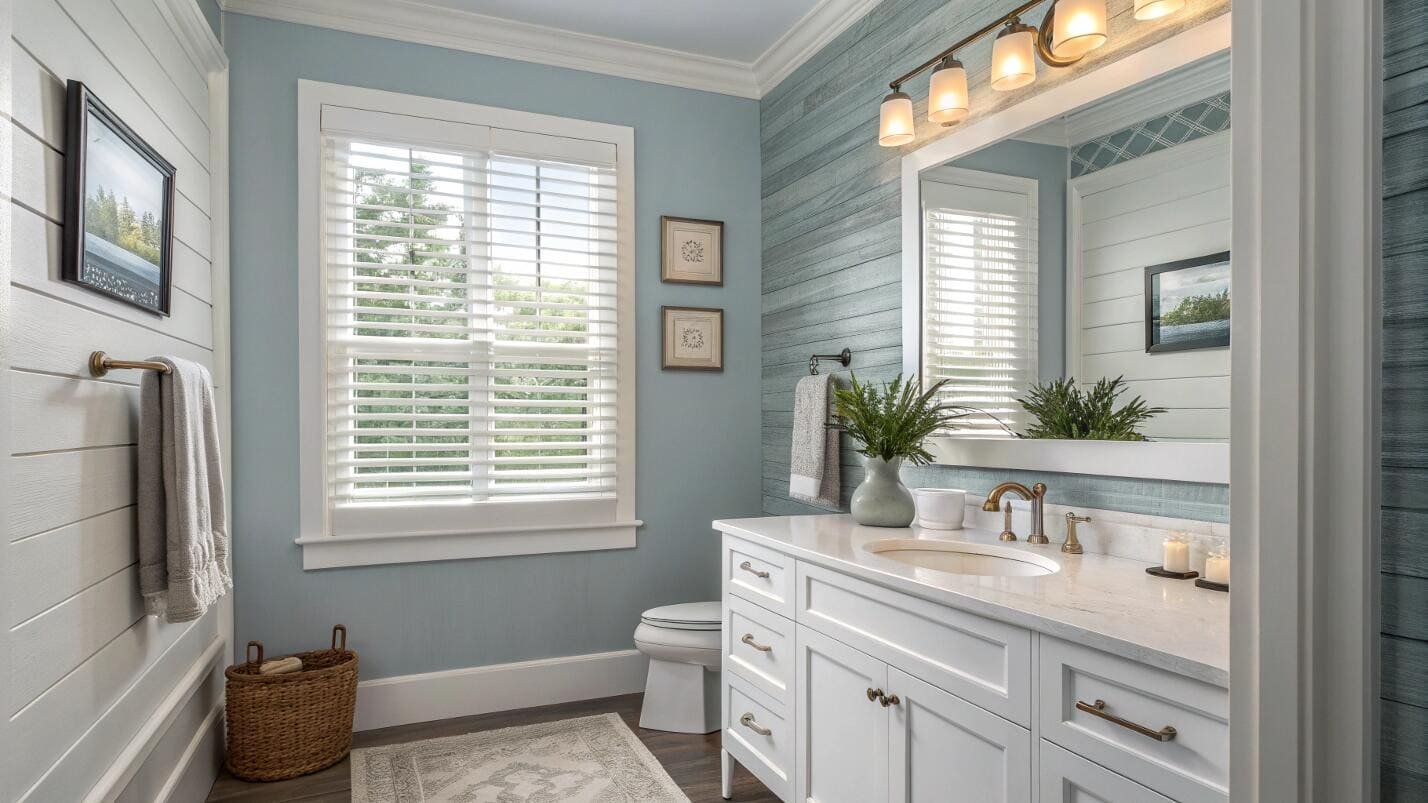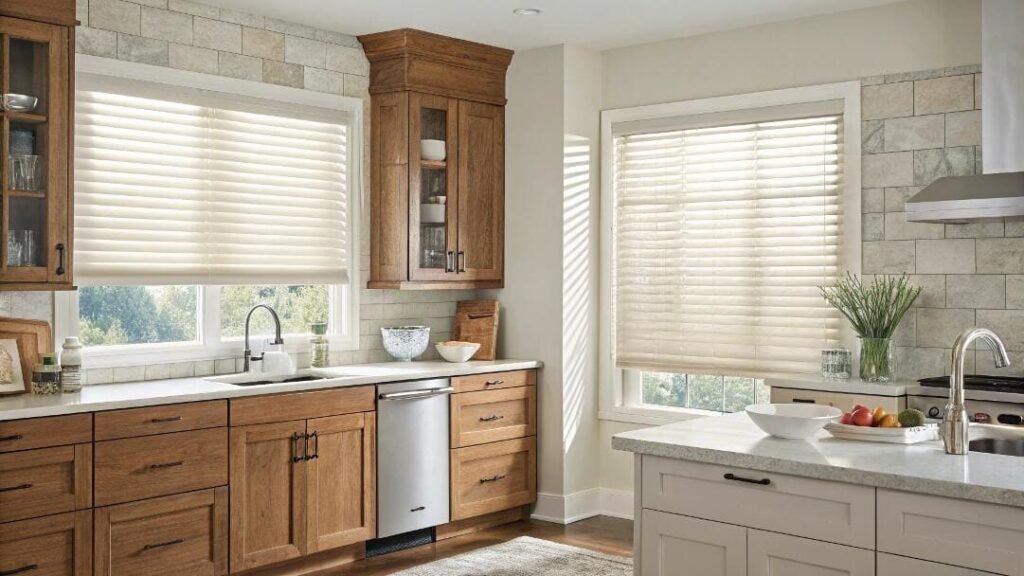Humid spaces breed ugly mold on window treatments[^1]. This ruins aesthetics and can be a health concern. Here's how to choose materials that stay clean and pristine.
Choose blinds made from non-porous, inorganic materials like faux wood, PVC, vinyl, or aluminum. For shades, select synthetic fabrics like polyester or fiberglass-core solar screens[^2], as these materials do not support mold growth.

I've supplied projects in coastal Florida and tropical Southeast Asia. I've seen firsthand how the wrong material choice can lead to a moldy disaster within months. The secret isn't a magic spray; it's choosing the right foundation from the very beginning. Let's explore the materials and strategies that guarantee a clean, long-lasting installation, even in the most challenging, humid environments.
What are the best materials for blinds and shades in humid climates?
You specified a beautiful window treatment, but humid weather turned it into a moldy mess. Natural materials absorb moisture, leading to warping and rot. Here's what to choose instead.
The best materials are synthetic and non-porous. Choose faux wood[^3] (a PVC[^4] composite), vinyl[^5], or aluminum for blinds. For shades, select polyester fabrics, PVC-based roller shades, or vinyl-coated fiberglass solar screens. These materials resist moisture absorption.

The number one rule for humid environments is to avoid giving mold anything to eat. Mold thrives on organic, porous materials. Real wood, cotton, and linen are like a buffet for mildew because they absorb and hold moisture. This is why we guide our clients toward synthetic alternatives. Faux wood, for example, gives you the classic, warm look of real wood but is made from a PVC composite that is completely waterproof. You get the aesthetic you want without the risk of warping, cracking, or mold growth. The same logic applies to fabrics. While a linen shade looks beautiful, a polyester or fiberglass-core solar screen will provide far superior performance and longevity in a damp climate because its fibers are inorganic and don't hold moisture. It's a simple material swap that makes all the difference.
What are the best window treatments for humid bathrooms and coastal areas?
A steamy bathroom or salty coastal air can destroy a window treatment. Constant moisture leads to rust, warping, and peeling paint, making your project look rundown fast.
Faux wood blinds are the top choice for bathrooms due to their waterproof nature and classic look. For coastal areas, consider aluminum blinds or high-performance solar shades with corrosion-resistant components[^6] to withstand salt spray and intense UV exposure.

The environment dictates the ideal product. For a residential bathroom, nothing beats the performance of faux wood blinds. They look great, offer excellent privacy, and are completely unfazed by daily steam from the shower. You can wipe them clean, and they will never warp.
Coastal climates present a double threat: high humidity and corrosive salt in the air. For a recent hotel project in Miami, we had to account for both. While faux wood is a good option, for window walls with amazing views, we recommended our motorized solar shades. The key here was in the components. We specified shades with stainless steel chains[^7] and corrosion-resistant headrails. Standard metal parts would rust within a year. The solar screen fabric itself is perfect for coastal areas because it's UV stable, resists moisture, and allows you to preserve the view while cutting the intense glare and heat.
How can you proactively prevent mold from growing on your blinds?
Cleaning mold is a reactive, unpleasant task. It's frustrating to see dark spots reappear on blinds you just cleaned. The key is to create an environment where mold can't start.
Prevention combines material choice with moisture management[^8]. Select non-porous materials like faux wood or vinyl. Ensure the room has adequate ventilation, and consider fabrics with built-in antimicrobial coatings which inhibit the growth of mold and mildew.

You can win the fight against mold before it even begins by focusing on three key areas. This strategy is essential for projects in healthcare or hospitality, where cleanliness is paramount.
Three Pillars of Mold Prevention
- Material Selection: As we've discussed, this is your first line of defense. Choose inorganic materials that don't provide a food source for mold. This is the single most important decision you will make.
- Moisture Control: Mold cannot grow without moisture. A well-ventilated room is crucial. Encourage the use of exhaust fans in bathrooms and kitchens. In extremely damp climates, a dehumidifier can make a huge difference in keeping ambient humidity levels low.
- Antimicrobial Technology: For an extra layer of protection, especially in sensitive environments, ask about fabrics with antimicrobial properties. At VelaBlinds, we can source high-performance roller shade fabrics that have technologies like Microban® integrated directly into the material. This isn't a spray-on coating that wears off; it's a permanent feature that actively inhibits the growth of mold, mildew, and odor-causing bacteria for the life of the shade.
What installation details are critical for blinds in humid environments?
You chose the right materials, but the blind still failed. Trapped moisture from improper installation can cause unseen damage to the window frame and headrail, leading to rust and rot.
Ensure there is adequate air-gap between the blind and the window pane, especially for inside mounts. Use stainless steel or corrosion-resistant mounting hardware. Proper spacing allows air to circulate, preventing condensation from being trapped.

Professional installation is more than just getting the blinds level. In humid environments, a few small details during installation can dramatically increase the lifespan of the hardware and prevent moisture damage. Trapped, stagnant air is the enemy.
The first critical detail is the hardware. In any room with moisture, or in any coastal region, standard steel screws and brackets are a recipe for rust streaks and failure. I always insist that my partners use stainless steel or other certified corrosion-resistant hardware for these jobs. It's a small upfront cost that prevents a major future problem.
The second detail is ensuring adequate airflow. When you take measurements for an inside mount, don't make it too tight. Leaving a proper air gap (e.g., 1/4 inch on each side) allows air to circulate between the blind and the windowpane. This circulation helps moisture from condensation evaporate instead of sitting trapped against the blind. For extremely damp areas, an outside mount is often an even better choice, as it naturally creates a larger air channel behind the blind.
How do you clean and maintain blinds to keep them mold-free for life?
Dust and grime have built up on your bathroom blinds. This organic buildup can become food for mold, even on resistant materials. Regular simple cleaning is the key to prevention.
Dust regularly with a microfiber cloth. For deeper cleans on faux wood or vinyl, use a soft cloth with a mild solution of water and vinegar. Avoid harsh chemicals. Ensure blinds are completely dry after cleaning.

Even the best mold-resistant materials need to be kept clean. Dust, soap scum, and other organic grime can settle on the surface of a blind and become a food source for mold. The good news is that maintenance is simple.
Simple Cleaning Guide
- Regular Dusting: The most important task is to dust the blinds every week or two with a microfiber duster or the soft brush attachment of a vacuum. This prevents any buildup from starting.
- Damp Wiping (for Faux Wood/Vinyl/Aluminum): For a deeper clean, mix a solution of 50% water and 50% white vinegar. Lightly dampen a soft cloth with the solution and wipe down each slat. The vinegar acts as a natural, gentle disinfectant.
- Dry Thoroughly: After wiping the blinds, go over them with a dry cloth to remove any excess moisture. This prevents water spots and ensures no dampness is left behind.
- What to Avoid: Never use abrasive scrubbers or harsh chemical cleaners like bleach, as they can damage the finish and texture of the slats. Don't saturate fabric shades with water; stick to light vacuuming or follow specific manufacturer guidelines.
Can blinds actually help reduce humidity in a room?
The room feels damp and stuffy. You wonder if your window treatments are part of the problem or the solution. Can they do more than just block light and provide privacy?
No, blinds do not directly reduce humidity. They do not absorb or remove moisture from the air. However, solar-blocking blinds can indirectly help by reducing solar heat gain, which can lower the workload on air conditioning systems that dehumidify.

"Bathroom White Blinds")
This is a common question, and it's important to be clear: blinds are a passive system and cannot actively dehumidify a room. They don't have fans or desiccants. Their role in humidity management is indirect but can still be significant.
The primary function of an air conditioning system is to cool the air, but a critical secondary function is dehumidification. As the A/C runs, it pulls moisture out of the air. This is where high-performance window treatments come into play. A solar shade, for example, can block up to 95% of the solar heat gain from entering a room through the window. By keeping the room cooler, the blind reduces the amount of time the air conditioning needs to run to maintain the target temperature. A more efficient, effective A/C system is also a more effective dehumidifier. So, while the blind itself doesn't remove humidity, it's a key part of an energy-efficient building system that manages both temperature and moisture.
Conclusion
To guarantee mold-free blinds, select non-porous materials like faux wood and synthetics. Combine this with proper ventilation, corrosion-resistant installation, and regular cleaning for long-lasting performance in any humid environment.
---
[^1]: Choosing the right window treatments is essential for preventing mold and ensuring durability.
[^2]: These screens provide excellent UV protection and moisture resistance, perfect for humid climates.
[^3]: Faux wood blinds offer a classic look without the risk of warping or mold, making them ideal for humid spaces.
[^4]: PVC is a versatile material that resists moisture, making it perfect for blinds in humid climates.
[^5]: Vinyl is moisture-resistant and easy to clean, ensuring longevity in humid environments.
[^6]: Using corrosion-resistant components ensures durability and longevity in humid and coastal environments.
[^7]: Stainless steel chains prevent rust and ensure the longevity of window treatments in humid areas.
[^8]: Effective moisture management is key to preventing mold growth and maintaining clean window treatments.Partner with VelaBlinds for Your Next Project
Smart window treatments shouldn't be complicated. After working with 500+ distributors and contractors worldwide, I've streamlined the process to get you quality products, competitive pricing, and reliable support - every time.
Why project professionals choose VelaBlinds:
- ✅ Fast, Accurate Quotes - Detailed specs and pricing within 24 hours
- ✅ Transparent Pricing - No hidden fees, volume discounts clearly outlined
- ✅ Quality Assurance - Direct partnerships with certified OEM manufacturers
- ✅ Project Support - Dedicated account manager from quote to delivery
Start your next project:
📧 Quick Quote: Send your requirements to info@velablinds.com
📱 Direct Contact: WhatsApp +86 137 2012 8317
🌐 Browse Solutions: https://velablinds.com/
📁 Product Resources: Access spec sheets, catalogs & project files
Paul Chen, Founder
"I built VelaBlinds to solve the real challenges I faced as a project buyer - long lead times, unclear specs, and unreliable suppliers. Let's discuss how we can power your projects with smarter blinds."
Serving distributors and contractors across North America, Europe, and Australia since 2018.




